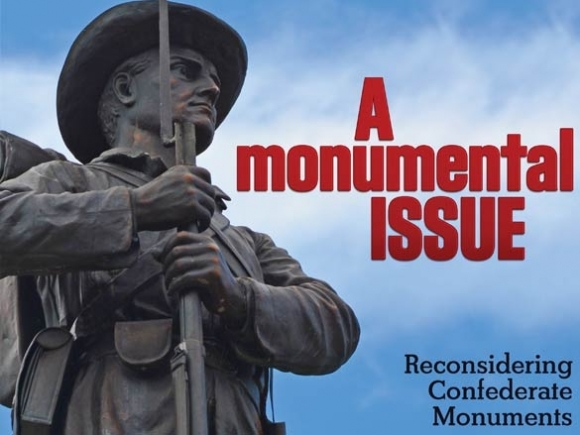A monumental issue

Lost in the ugliness of the recent Charlottesville violence is the fact that the demonstration was originally centered around the proposed removal of a statue of Confederate General Robert E. Lee.
But after protesters toppled a similar statue in Durham, new scrutiny has come to the nation’s 1,503 Confederate memorials – plaques and parks, statues and schools, cities and counties, highways and holidays, and even national forests.
SEE ALSO: Governments across the nation consider removing Confederate monuments
Proponents revere these monuments as a reminder of a common history and heritage, but detractors revile them as perpetuating the glorification of slavery.
Now, governments across the country must grapple with a monumental issue that is already tearing open centuries-old wounds that have never fully healed, especially in the post-bellum American South.
Related Items
The Lost Cause
On Friday, Aug. 11, a protest in the college town of Charlottesville, Virginia, over the proposed removal of a Confederate statue turned violent, as white supremacists, neo-Nazis, and other far-right groups availed themselves of the opportunity to showcase their views to the country and the world.
Counter-protesters from the left similarly availed themselves of the opportunity; clashes were reported that Friday, but the death of 32-year-old Heather Heyer on Saturday, allegedly at the hands of a 20-year-old Ohio man said to hold right-wing views, shocked and horrified many from both sides.
One day later, on Aug. 14, demonstrators in Durham pulled down a statue depicting a generic, anonymous Confederate soldier.
As it fell, in all likelihood so fell with it the hopes of achieving a systematic and intelligent cultural conversation leading to a satisfactory resolution of the issue. Further complicating the situation was President Donald Trump, who on Aug. 13 failed to call out white supremacists, instead saying, “We condemn in the strongest possible terms this egregious display of hatred, bigotry and violence on many sides.”
Despite relentless social media mocking, Trump doubled down on that non-statement days later with a contentious press conference described by The Washington Post as “off the rails” and by CNN as “a meltdown for the ages,” where he again blamed all sides.
Left unanswered are a litany of questions; 22-year-old Takiya Thompson was arrested for the incident in Durham along with three others charged with felonies related to inciting and participating in a riot and damaging property.
In a nation of laws such as this, the destruction of public or private property has never been tolerated, except when it has — like during the Boston Tea Party.
What makes Thompson’s act, for that matter, any different than those of Paul Revere, who committed more than his fair share of tea to the briny waters of Boston Harbor?
And in a nation of laws such as this, it has long been held that violence instantly de-legitimizes any protest, except when it doesn’t — like during the Boston Massacre, where mixed-race runaway slave Crispus Attucks became one of the first casualties of the American independence movement.
And more specifically to this issue, what level of culpability in slavery is sufficient for a person to have their memorial removed? Is it the hapless, slaveless Western North Carolina Confederate conscript who died fighting for that which what he knew not — the complicated issue of states’ rights?
Or is it instead Lee, who was by all accounts an honorable man with decades of heroic military service to these United States upon which he would one day treasonously turn his back?
Is it none of them? Or, is it all of them?

Fiddle-dee-dee
According to a now-widely circulated report by the Southern Poverty Law Center called “Whose heritage? Public Symbols of the Confederacy,” North Carolina’s 140 — now 138 — monuments place it fourth among states with monuments, following only Virginia, Texas and Georgia.
In 2015, North Carolina’s Republican Gov. Pat McCrory signed a law that prevents the alteration, relocation or removal of plaques, memorials and monuments on public property without the permission of the North Carolina Historical Commission.
It’s ironic, but not uncharacteristic of McCrory’s administration — purportedly a conservative, small-government administration — to take out of the hands of local lawmakers the ability to decide what is best for their own communities, as with his controversial bathroom bill, HB2.
But on Aug. 15, North Carolina’s Democratic Governor Roy Cooper did the same in calling for the removal of all publicly maintained Confederate memorials, asking the Republican-controlled legislature to repeal the 2015 law.
An op-ed authored Aug. 17 by President Pro Temp of North Carolina Senate Phil Berger, R-Eden, called Cooper’s request “reactionary and divisive.”
President Trump on Aug. 17 called such removals “foolish.”
Cooper also asked the North Carolina Department of Cultural Resources to assess the cost of transporting Confederate monuments to museums.
That cost could certainly add up, but at this point, can the state afford not to remove them?
The City of Wilmington leads North Carolina — the state that furnished the Confederacy with more soldiers than any state besides Virginia — with 14 monuments, roads or holidays dedicated to Confederates; Charlotte, Salisbury and Raleigh have six, Mebane has five, Kinston and Spencer have four.
Durham now has none.
Rep. Michele Presnell, R-Burnsville, voted in favor of the 2015 measure, and says she still supports it.
“Now more then ever,” Presnell said via email Aug. 17. “ALL MEMORIALS [emphasis hers] should stay just like they are currently.”
In a further statement Aug. 18, Presnell decried the “cultural cleansing” she compared to the Nazi destruction of Poland in the 1940s, the Soviet obliteration of Christian churches in the 1960s, the Al Qaeda dynamiting of 1,400-year-old Buddhist statues in Afghanistan in 2001 and the ISIS annihilation of Iraq and Syria’s cultural antiquities that continues today.
Bryson City Republican Rep. Mike Clampitt wasn’t in the North Carolina General Assembly in 2015, but says he also doesn’t believe in removing or relocating Confederate monuments or any other publicly owned articles of history.
“Everyone should respect the beliefs, rights and privileges of others,” he said Aug. 17. “By not doing so, it is as reprehensible as the acts of violence. Let us embrace all our nation’s history, and by remembering it, our future will not be doomed by repeating it. May we respect and honor Confederate soldiers, their courage, their sacrifices, and that they, too, were Americans and are recognized by the federal government as honored veterans.”
Sen. Jim Davis, R-Franklin, said he too was against the removal of North Carolina’s Confederate monuments.
“I don’t think it’s a good idea,” said Davis, adding that those who don’t remember their history are doomed to repeat it.
“I’m not willing to let people tell us what they think the Civil War was about,” he said. “Certainly slavery was part of the conversation, but so was states’ rights.”
As an example, Davis said that his great-great-grandfather, along with three of his brothers, was present at the Confederate surrender at Appomattox Court House in 1865, and then walked home to Western North Carolina.
“They were conscripted into the Confederacy and none of them owned slaves,” he said. “They weren’t fighting for slavery. I don’t support slavery. I never have. I think it’s a blight on our country.”
The fact that the very existence of those monuments may make some people, particularly African-Americans, feel unwelcome in their own communities didn’t sway Davis, who wanted to know where, exactly, it would end — echoing comments made by President Trump Aug. 15, when he asked if founding fathers and slaveholders George Washington and Thomas Jefferson would be next.
Creating policy based on who gets offended, Davis said, would “paralyze” government.
“My last name is Davis, and Jefferson Davis was the President of the Confederacy. Am I supposed to change my last name to make people feel better?”
 A dream remembered
A dream remembered
The first Confederate memorials began to appear before the war had even really begun.
Baker County, Florida, was founded in 1861 and named for James McNair Baker, a Confederate senator.
Blakely, Georgia, is home to the last remaining Confederate flagstaff in the United States, which has stood in Court Square since it was carved from a lone local longleaf pine, hauled a mile and erected in May 1861.
Bartow (formerly Cass) County, Georgia was in 1861 re-named after Confederate politician Francis S. Bartow, who lived in Savannah 200 miles away and had never even been to the county but was far more popular than the unionist Gen. Lewis Cass, who served as President Andrew Jackson’s Secretary of War.
According to the SPLC report, from the 1860s on, memorials began appearing with ever-increasing frequency until the early 1900s, at which point they tripled or quadrupled in volume through the Jim Crow era of the early 1920s.
After that, a great lull occurred until the beginning of the civil rights era in the late 1950s. Monument erection then slowed to a trickle, although as recently as 2014, a plaque was placed in Fredericksburg, Virginia, to commemorate the 846 casualties of Maj. General Jubal Early's division killed in the defense of the city in 1863.
The very existence of such monuments at all is curious.
Objectively, the presence of mementoes honoring vanquished rebels in the country that outlasted and eventually overwhelmed the rebellion is a unique instance, to say nothing of the promulgation of the defeated army’s imagery, like the Stars and Bars.
But that probably traces to the liberal surrender terms President Abraham Lincoln dictated to Commanding General of the U.S. Army, Ulysses S. “Unconditional Surrender” Grant.
Grant conveyed those terms to Lee at Appomattox Court House on April 9, 1865, while Sen. Jim Davis’ ancestors presumably contemplated their 375-mile walk home.
Two days later, Lincoln — from the candle-lit North Front of the White House — gave his final public address.
“We meet this evening, not in sorrow, but in gladness of heart,” he told an assembled crowd outside. “The evacuation of Petersburg and Richmond, and the surrender of the principal insurgent army, give hope of a righteous and speedy peace whose joyous expression can not be restrained.”
If Davis’ ancestors were officers, they would have been allowed to keep their horses, to help with the late planting and grim harvest that would soon ensue.
The fact that they were allowed to keep their lives, like Lee and Jefferson Davis and every other major Confederate commander, is also indicative of the generous terms Lincoln felt would speed reunification; neither reprisals nor show trials nor torture nor mass executions nor imprisonment occurred — also a curious, unique instance in the ancient global history of war.
Confederates were simply asked to refrain from taking up arms against the United States again, and sent home to their families.
“Nor must those whose harder part gives us the cause of rejoicing, be overlooked,” Lincoln told the crowd. “Their honors must not be parceled out with others.”
Lincoln was assassinated by a member of that crowd just six days later.
The miseries of the world
“My family came here in the late 1700s. They were just farmers,” said Alex McKay, one of Haywood County’s most prominent preservationists and history buffs.
Inside the old Haywood courthouse, McKay runs the Haywood County History Museum, which contains several pieces of Confederate memorabilia.
“Having an old family from this area, I grew up around it,” he said of the hundreds of other local relics — like old signs from Dayco and menus from area lodges long since vanished — contained in the tiny former jury room on the second floor. “I grew up hearing stories about the Civil War that my grandparents told my parents and I had family in the Revolutionary War as well.”
Among his prized possessions, he said, was a belt worn throughout the war by the man who delivered the news of Lee’s surrender to Waynesville, D.M. Killian.
Few have called for the outright destruction of Confederate monuments; even the most ardent removalists have suggested museums like McKay’s as the proper place for such articles, that they might remain part of our nation’s history and be used as educational tools for future generations.
Just outside McKay’s window, in front of the courthouse on county-owned land, sits one of two Confederate memorials the SPLC report says are in Waynesville.
The 20-by-28-inch bronze rectangular plaque, set in a 5-by-6-foot granite boulder, was dedicated on July 12, 1940 and reads “To honor and commemorate the Confederate veterans of Haywood County. Erected by the Haywood Chapter United Daughters of the Confederacy 1940.”
Haywood County Commissioner Mike Sorrells said that it’s a sensitive issue, with high emotion on all sides; but unless and until the legislature repeals McCrory’s 2015 law, Sorrels said any discussion of the Haywood plaque is premature.
“I’m a local control advocate. I think that’s one of the ways they’ve taken power from local governments to decide what’s best in their own communities,” Sorrells said.
“It’s part of history just like Vietnam was or World War I,” McKay said. “We’ve got several monuments out there on the courthouse lawn. I don’t know why this would be any different.”
The fact that the plaque is intended to honor generic and anonymous veterans rather than a particular slaveholder may be what makes it different; less ardent removalists — especially in mountainous Southern Appalachia, where extreme poverty and lack of plantation-style agriculture conspired to keep slave populations far lower than in other parts of the South — recognize that the plight of Confederates like Sen. Davis’ and McKay’s ancestors was probably little better than the millions of Midwestern farm boys they were forced to fight.
“A lot of people are looking at that time with modern eyes,” said McKay, who also serves on Waynesville’s Historic Preservation Commission, which has of late been tireless in efforts to bring greater recognition to the town’s historic African-American community along Pigeon Street. “My family members, my ancestors that were here in Haywood County in the Hemphill section, they didn’t have slaves, but they fought for the Confederacy.”
Not every white Southerner was as eager to rush off to war as Margaret Mitchell’s Tarleton twins were in her 1936 novel Gone With the Wind, but like Mitchell’s iconic Scarlett O’Hara, many instead saw the war come to them.
“When you’ve got Kirk’s raiders coming in to Waynesville, burning homes, raping women and taking everything they had, you’d fight against it,” McKay said.
Col. George Washington Kirk’s 3rd North Carolina Mounted Infantry was an all-volunteer force that terrorized Western North Carolina — including Waynesville — with what were at the time unconventional guerilla tactics.
“They burned the jail and released all the prisoners,” said McKay. “The Thomas Legion of our local regiment was made up of Cherokee Indians and mountain men. They saved Waynesville from being completely burned.”
The 69th North Carolina Regiment — sometimes known as Thomas’ Legion of Cherokee Indians and Highlanders — also fired the last shots of the Civil War east of the Mississippi River almost a full month after Lee’s surrender at Appomattox and shortly before negotiating the surrender of Union Colonel William C. Bartlett's 2nd North Carolina Mounted Infantry.
Bartlett’s forces had been pillaging and plundering in and around Waynesville.
Far outside Waynesville, near Devil’s Courthouse in southern Haywood County, is another monument of sorts — a 125-acre forest with 125,000 balsam and red spruce trees, spaced at 6-foot intervals.
Planted from 1941 to 1943, the trees are meant to symbolize the 125,000 North Carolinians who served as Confederate soldiers.
Called the North Carolina Confederate Veterans Memorial Forest, the site is on U.S. Forest Service land in Pisgah National Forest.
Federal jurisdiction over the forest prevents county officials from doing anything about it — even if they wanted to — and McCrory’s state law prevents them from changing the status of the plaque out in front of McKay’s museum.
Out in front of the Jackson County Public Library in Sylva — at what was once the county’s courthouse — has stood since 1915 a colossal column topped with a copper statue of an anonymous, generic Confederate infantryman.
“To our valiant fathers: champions of reconciliation with justice, of union with manhood, of peace with honor; they fought with faithfulness, labored with cheerfulness, and suffered in silence,” reads a plaque on the west face. “To our heroic mothers: Spartan in devotion, Teuton in sacrifice, in patience superior to either and in modesty and grace matchless among womankind.”
The monument stands on county-owned land; Brian McMahan, chairman of the Jackson County Board of Commissioners, said he thinks it’s a teaching tool that can be used to illuminate the past, present and future.
“The monument in Sylva is meant to honor the average Civil War soldier who came from Jackson County,” McMahan said. “It doesn’t honor any specific person. It’s a reminder of an era in our history.”
Swain County isn’t listed as having any Confederate monuments on publicly-maintained land and instead has a World War II-era statue honoring local dead from World War I, World War II, Korea and Vietnam in front of the Swain County Courthouse in Bryson City.
But in Macon County, perhaps the most prominent Confederate memorial in the area stands conspicuously in an immaculately-maintained park near the heart of Franklin’s quaint downtown retail district.
It was there on Aug. 18 that about a half-dozen supporters of Confederate imagery gathered — for the third night in a row — to clear up what they say is confusion about their cause.
“They’re trying to say it’s a symbol of hate,” said Joey Toneges, one of the demonstrators at the 25-foot-tall marble statue. “It’s not about hate.”
Tonegas and several others arrived around 7:15 p.m. that night, setting Confederate and U.S. flags atop their cars, then waving Confederate flags in the park and on the sidewalk near the monument, upon which is inscribed a paean to “the sons of Macon County who served in the Confederate Army during the war period.”
Another man donned a Confederate flag and wore it as a cape while he waved a pair of large Confederate flags at traffic, shouting “All lives matter!” to the encouraging honks of several cars.
The event wasn’t marred by violence and was mostly without incident, but for one; an unidentified white male walked by, exchanged vulgarities with three of Toneges’ companions, and then attempted to engage in a profanity-laced history debate with them.
“I’m born and raised, North Carolina, boys, born and raised,” the man shouted. “Mountain people didn’t have slaves! We didn’t want to fight for those fucking people … they sent us up to die!”
“It’s about the history,” said a woman with the demonstrators. “If you’re not going to support, then you need to walk away.”
“I’m a Southerner! We lost! And it was right that we lost!” he shot back. “If you’re God-fearing people you don’t need to be with any of this shit.”
The man departed without further incident, but by that time, Franklin police and Macon County Sheriff’s personnel began assembling at the scene. They were soon joined by Franklin Mayor Bob Scott, who directly addressed Toneges and those gathered with him.

“You can stay here and do it, but let me tell you — you’re hurting the town and everyone that’s in it,” Scott told Toneges as one of several children who came with them waved the Confederate flag nearby.
“I’m sorry, but that’s what you’re doing,” Scott continued. “It’s on your plate.”
“I’ll eat it,” Toneges said.
“OK,” Scott seethed. “Because I believe you’re going to have to.”
Scott explained that the monument stands on county-owned land but is maintained with help from the city and volunteers from a local garden club; no government funds, to his knowledge, went into the creating it. He also added that although state law would again prevent any alteration to the monument, there are no plans to do so anyway.
“Absolutely not,” he said. “But what this is doing is drawing attention to it. I have asked them not to do it, but I can’t tell them not to do it, because they’re in their First Amendment rights to do it.”
That the demonstration took place on a busy Friday night just as tourists chasing a once-in-a-lifetime solar eclipse streamed in from Atlanta, Charlotte and points beyond to bask in the town’s totality seemed particularly to perturb Scott.
“I don’t like it at all. It’s an embarrassment to the town,” he said. “We’ve got people here from all over the United States, and they’re here in a prominent place.”
Still, the solution to this monumental issue remains elusive for Scott, Franklin, Western North Carolina and the rest of the United States.
“Cooler heads need to prevail,” he said.
But are there any left?
“I think so,” he laughed. “The question is, are they being heard?”
Confederate symbols in the United States
• Symbols of the Confederacy in public spaces: 1,503*
• Confederate monuments on public property: 700
• Public schools named after Confederates: 109
• Major military bases named after Confederates: 10
• States with official Confederate holidays or observances: 9
• States with publicly supported Confederate flags: 6
*Data does not reflect removals after August 10, 2017
Source: Southern Poverty Law Center
U.S. public schools named after Confederates
• Robert E. Lee: 52
• Thomas “Stonewall” Jackson: 15
• Jefferson Davis: 13
• P.G.T. Beauregard: 7
• Nathan Bedford Forest: 7
• J.E.B. Stuart: 5
Source: Southern Poverty Law Center









